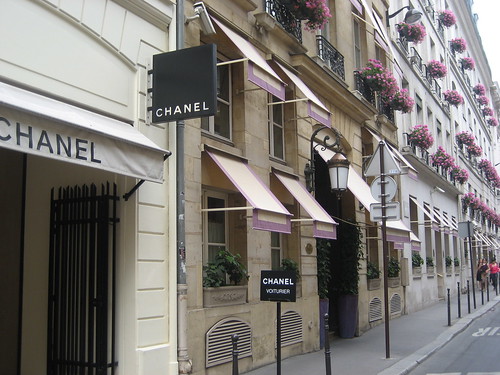31 Rue Cambon
For some reason, I can never get overly excited about furniture. And when trying to think what is the best visual way to portray 31 Rue Cambon, I cannot stop thinking of neutral coloured furniture. I can admire the architecture of the bottle (magnetic cap maintains the alignment of the mirrored "cc" logo at all times). I can intellectualize about the validity of oakmoss-free chypre and analyze the construction of the fragrance. But as of yet, I remain unaffected, no matter how comfortable or elegant this fragrance may be.
At this age of technology and the internet leaking inside information about perfumes well before anyone could sniff them, it’s hard to keep an open mind and untainted or opinionated approach when smelling perfume for the first time.
I’m trying to remember what was I expecting from 31, Rue de Cambon before getting directly acquainted with it. I wasn’t expecting a particular kind of scent or mood or notes. No, the emotions were a mix between high-hopes and advance disappointment, combined together to create an accord of mixed feelings and suspicion. Keep in mind that 2007 was marked by serial niche releases – i.e. launching a collection of even as many as 12 perfumes instead of focusing on just one. Tom Ford Private Blends and Le Coffret from Thiery Mugler (to coincide with the movie release of Perfume: The Story of a Murderer) are just two prime examples of what is perhaps a new strategy to avoid bad reviews: overwhelm perfume bloggers and critiques with so much information that they simply don’t bother testing, thus avoiding possible negative criticism. The rationale, of course, is to get the consumer to such a heightened sense of confusion that will prompt him/her to purchase the entire collection instead of just one perfume.
So here I am, 2 years after 31 Rue Cambon saw the light of day, finally trying to pay more attention to it as a single fragrance. In the context of the entire collection released back in 2007, 31 Rue Cambon stood out right next to the quirky, nutty unpolished ambrette seeds of No. 18. Back than it reminded me of the understated woody and aldehydic-floral juxtaposition of Bois des Îles. Two years later, I’m still impressed with the first few moments of intrigue, where 31 Rue Cambon smells like how you’d expect a luxury good boutique to smell like (reference: Hermès Poivre Samarkand). For a few moments, the juxtaposition of orris, pepper and vetiver seems equally classy and fresh (in the sense of “new”). But is that really how “the best chypre of thirty years” that would “permanently change the landscape of perfumery” suppose to smell like?
Or is it even a Chypre? Taking a closer sniff of it in recent weeks I’m even less convinced than I was ever before. Despite the fact that 31 Rue Cambon has the Chypric characteristic of creating a general homogenous impression at first, refusing to unveil what it’s made of right away, the threads that connect the elements are not as tightly woven as in a classic Chypre. And even though it does provide the sudden emergence of voluptuous flowers (jasmine and narcissus) it is not enough to get one’s heart racing as florals soar into the atmosphere – as one would experience in great Chypres such as Mitsouko, Femme or Miss Dior. And finally, lest me remind you that there is no oakmoss here so even when you get to the base of things I never got the satisfaction of dusting my feet in crushed dead autumn leaves or dampening my leather sandals in mossy forest floor. Instead, all I got was a thin layer of a vague woody-synthetic mixture of vetiver and patchouli that have been stripped down to their minimum representation – thus lacking any of the earthy foundation that makes a Chypre perfume so alluring and timeless. Chypre, after all, the epitome of urban chic born of the chaos of nature. It is complexity that made Chypres so near and dear to the perfumer and have in many ways, defined what was to become of modern perfumery.
I’ve been wearing 31 Rue Cambon for a few weeks now before bedtime and almost every single time I do I wake up 20 minutes later with an overwhelming olfactory sensation of heat and dryness. Testing it again yesterday morning, I was not surprised to find out that 20 minutes in this is the point where the synthetically-amplified patchouli kicks in. More than the lack of oakmoss, it’s the synthetic patchouli part that disturbs me in 31 Rue Cambon. Just as it does in Coromandel, Allure Sensuelle and earlier on – Coco Mademoiselle (and maybe also Chance, which I never was able to watch through the end because of its sharp edges and aggressive sillage). While the last two I’ve mentioned are far less hostile and have that sense of refinement – achieved by using the “precious woods” aspects of vetiver and patchouli.
And one last observation about the Les Exclusifs collection – I now realize that the six scents have more in common than I even thought before: An iris thread goes through the green and fresh Bel Respiro and 28 La Pausa (both contemporary reflections on No. 19), through the sparseness of No. 18 and on to the more complex 31 Rue Cambon* which in addition to iris also has the same patchouli theme as Coromandel. And the vetiver finally leads us Sycomore, the redeeming point in the collection.
Top notes: Pepper, Bergamot
Heart notes: Orris, Narcissus, Jasmine
Base notes: Patchouli, Ambrette, Vetiver, Labdanum
* Both No. 18 and 31 Rue Cambon being reflections of Bois des Iles


